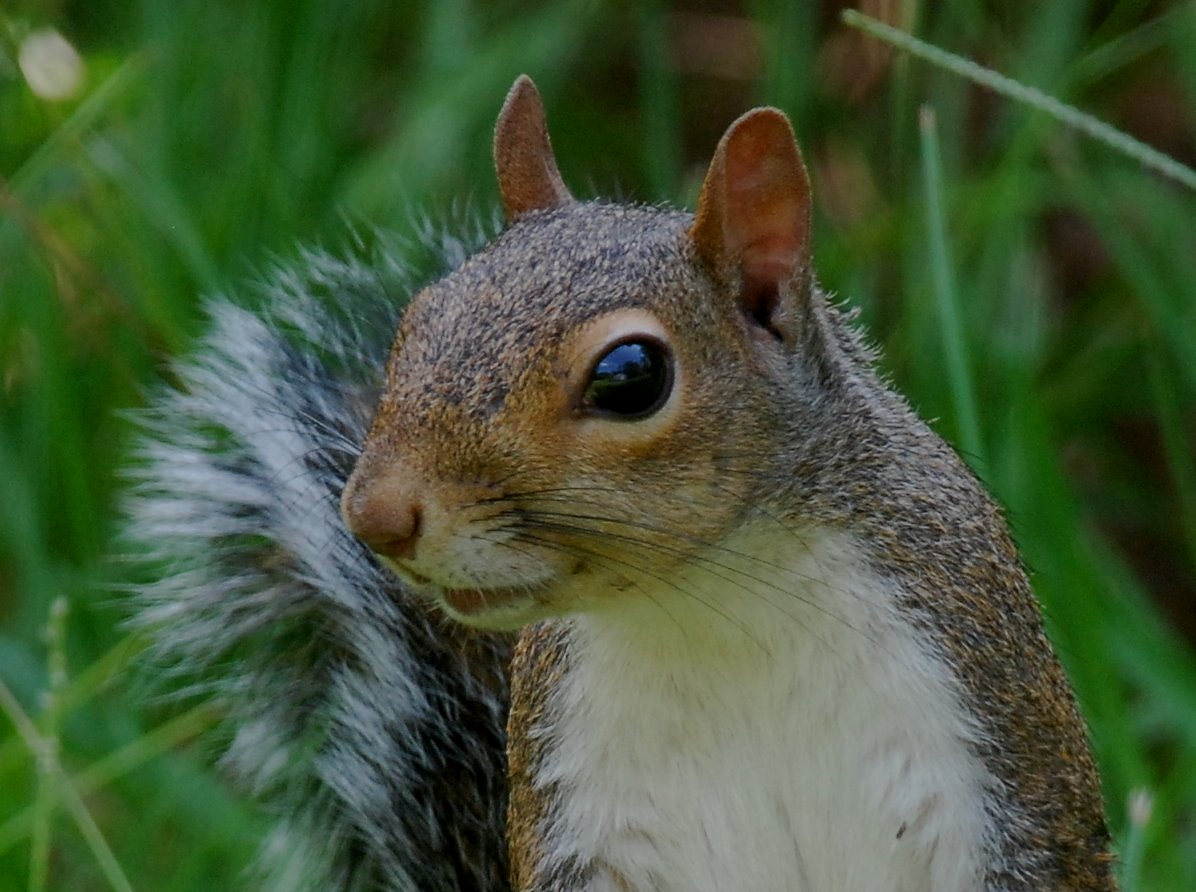
Gray squirrel (Terry W. Johnson)
By Terry W. Johnson
The gray squirrel is a familiar sight throughout Georgia. We see them dining in our backyards on everything from birdseed to tomatoes and other vegetables, tight-roping power lines across roads in cities and suburban neighborhoods, and searching for food in the woodlands that blanket much of the Peach State. In fact, gray squirrels are so common we overlook the fact that each day these small mammals face the threat posed by a host of predators ready to make a squirrel their next meal.
The animals that feed on gray squirrels in our neck of the woods includes coyotes, foxes, dogs, cats, rattlesnakes, gray rat snakes, bobcats, weasels, raccoons, red-tailed hawks, both barred and great horned owls, and even largemouth bass. (A gray squirrel was found in the stomach of largemouth bass.) While most of these predators eat adult and young squirrels, raccoons and gray rat snakes prefer to prey on nestlings.
However, the truth is that humans represent the greatest threat to gray squirrels. Untold numbers are killed by vehicles racing down our highways. In addition, thousands of gray squirrels are harvested across the state.
But when it comes to wildlife, gray squirrels use a suite of behaviors and physical attributes to foil the most skilled predators.
First, squirrels see the world in a far different way than humans. They are essentially equipped with sunglasses. A gray squirrel’s yellow lenses greatly reduce glare. Otherwise, its eyesight is equivalent to ours but with a red-green colorblindness. In other words, they can discern red and green but not other colors.
And while we can see objects directly in front of us better than we can those to the side, the gray squirrel's peripheral vision and focal vision are equally sharp. This allows a squirrel to spot a predator approaching from the side or from the front without having to move its head.
If this isn't enough, the squirrel’s eyes are positioned slightly upward. Biologists believe this enables the squirrels to go about their business while also keeping a sharp eye out for raptors overhead.
Gray squirrels use camouflage to remain out of the sight of would-be predators. As any squirrel hunter can attest, regardless of whether you hunt squirrels in late summer, autumn or winter, it’s difficult to spot a squirrel in the top of a tree. The animal's grayish to yellowish brown pelage blends in with the bark of the trees they most often inhabit. This makes one almost impossible to see unless it moves.
Often, when a squirrel recognizes it has been spotted it will scoot around to the backside of a tree and then peek around the trunk to see if a predator is still close by. While hunting I have often seen a squirrel scamper around to the backside of the tree to avoid danger. When I would walk around the tree trying to relocate it, the squirrel would simply crawl around to the opposite side.
Gray squirrels will also lay motionless on a branch, with only its feet and tail hanging down. In some instances, they will flatten their bodies against the tree’s trunk and remain motionless until a predator moves on.
These squirrels also take full advantage of their athletic abilities. If one is surprised while foraging on the ground, it can run away from danger at speeds up to 14 mph. Once it reaches a tree, it can then scamper up the tree at 12 mph.
Gray squirrels are great jumpers, as well. They can leap 6 feet or more from one branch or tree to another. They can also vault a distance of 16 feet when dropping from one limb to another. In addition, a squirrel can spring vertically from the ground at least 5 feet high. To put that into perspective, if we had this ability, we could leap from a sidewalk to the top of a five-story building.
Although they are not social animals, a gray squirrel will alert other squirrels when it detects approaching danger. They do this through a variety of sounds such as barks, squalls and other loud sounds. They can even make a catlike call (which is why gray squirrels are often referred to as cat squirrels).
Squirrels also use their tail as a warning flag. Tail waving often accompanies a barrage of warning sounds. It should be noted that portions of a gray squirrel's tail will often snap off when grabbed by a predator. However, unlike reptiles, which also have this ability, the squirrel’s tail does not grow back. Some zoologists feel gray squirrels will rapidly move their tail to confuse would-be predators. The theory is a snake or other predator might mistake the tail for an aggressive animal.
I think you would agree gray squirrels have an impressive array of weapons at their disposal to keep predators from catching them. Based on the numbers of squirrels I see, it would appear these methods are quite successful. Now if gray squirrels ever figure out how to avoid being hit by cars and trucks, we might be overrun with these fascinating wildlife neighbors.
Terry W. Johnson is a retired Nongame program manager with the Wildlife Resources Division and executive director of The Environmental Resources Network, or TERN, friends group of the division’s Nongame Conservation Section. (Permission is required to reprint this column.) Learn more about TERN, see previous “Out My Backdoor” columns, read Terry’s Backyard Wildlife Connection blog and check out his latest book, “A Journey of Discovery: Monroe County Outdoors.”




















